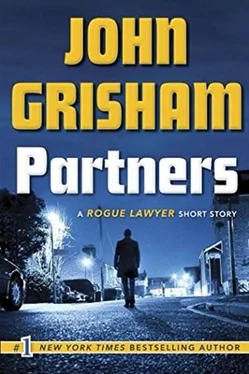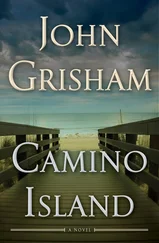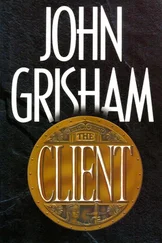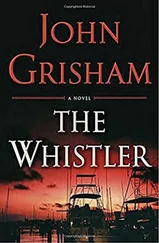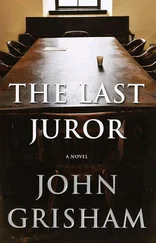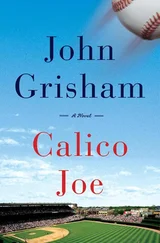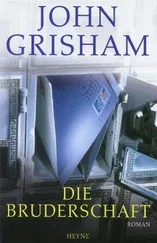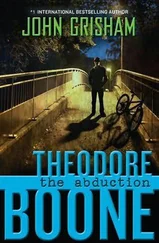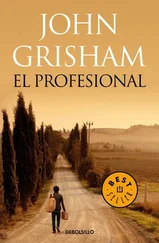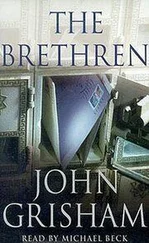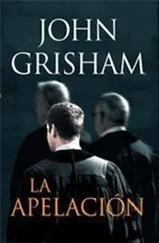A door opened and a guard appeared. He was followed by Cardell, who for the occasion was wearing a Kevlar vest, a helmet, and of course the usual assortment of chains and cuffs, all for a two-minute walk down the stairs from the protective custody wing on the fifth floor. Because of the wound to his left elbow, the guards had generously cuffed his wrists in the front and not the back. Two more guards crowded behind him. Sebastian shook his head in disbelief as they went about the task of removing the restraints. Cardell stood perfectly still, his eyes on the floor. The helmet came off.
When they finished, one guard said, “You have an hour.”
To which Sebastian replied, “Bullshit. I’m his lawyer. I have as much time as I need.”
“An hour!”
“Take the damned Kevlar vest off, okay? The guy is here to see me, his lawyer. You think I’m planning to shoot my own client?”
The guards laughed at the lawyer’s stupidity. They left the room and Cardell, still wearing the vest, dropped into the plastic chair and looked through the glass. He slowly took the phone hanging by the partition.
Sebastian picked up his and said, “I’m Sebastian Rudd, your lawyer.”
“Nice to meet you. I guess I’m your client.”
“I guess you are. And you go by Tee Ray, right?”
“Tee Ray works.”
“Tee Ray, we’re not going to talk in here. I’ve heard about this room. The cops around here are pretty stupid and they probably have this place wired. I’ll go to court Monday and get an order allowing us to meet on the second floor, where the attorney conference rooms are located. Those rooms are wire free, or so we think. So, let’s just say this is our first little hey-howdy meeting. We’re set for your first appearance next Wednesday in circuit court. I’ll be there, but we’ll talk ahead of time. Any questions?”
“My son-”
Sebastian threw up a hand. “Don’t say anything, because someone is listening. I’ve talked to Jameel, and I’ve talked to your mother, Miss Luella. A delightful lady. Jameel is living with an aunt while I try to arrange housing for him and your mother.”
Tee Ray nodded with gratitude but said nothing.
Sebastian said, “Don’t say a word about your case to anyone. I know you’re in a cell by yourself but that doesn’t matter. Every other inmate is likely to be a snitch, and he’ll pop up at trial and claim that you made a full confession. I’ll file a motion to keep you in solitary confinement. I know it’s not pleasant, but it will keep you away from potential snitches. You cannot trust anyone here, Tee Ray, do you understand this?”
He kept nodding.
“I’ll be back Monday afternoon and we’ll have a long chat. Until then, not a word.”
The Sunday edition of the Chronicle was chock-full of color photos of Buck’s grand farewell. The flag-draped coffin being carried from the cathedral; the pretty young widow in black; the hordes of cops in full dress (and from seven states!); the throng at the cemetery. Even the city’s polished fire trucks were used in the procession.
And on the front page of section B, Metro, there was a mug shot of Thomas Ray Cardell, the cold-blooded killer, the man who’d caused all the suffering. Next to him was a photo of his lawyer, the Honorable Sebastian Rudd, described as a “well-known criminal defense lawyer.”
When Rachel checked the voice mail early Monday morning, the third message came from a husky voice that promised, “If that nigger walks, Rudd’s a dead man.”
Bradley came through with his promise to procure testimony. The first witness was a nineteen-year-old part-time college student who lived two blocks from the Flea Market. His name was Jacoby, and he swore to Mr. Rudd that he saw Tee Ray on his knees with his hands in the air and that he heard four loud shots, then two not as loud. He also heard Tee Ray scream, “Don’t shoot!” but the shots kept coming. Jacoby claimed to be lurking in the shadows because he was in the process of sneaking into the Flea Market to buy some pot for himself and a friend. The friend happened to be the girlfriend of a rather rough character, thus the sneaking around.
A month before the trial, Jacoby disappeared. Vanished without a trace. The police searched and investigated and went through the motions but found no sign of Jacoby. Sebastian had warned him that he could be in danger, and the kid claimed to be lying low. His mother said she had been concerned because he had been flashing around some cash, but she had no idea where it had come from. A week into the search, Jacoby called home, said he was in L.A. with some new friends and wasn’t coming back.
Bradley and his boys swung into high gear and found another witness, an unindicted felon named Rufus. He claimed to have seen and heard everything, just like Jacoby. Sebastian spent hours with Rufus and became convinced the man could handle the rigors of a trial. He could stick to his story and withstand a brutal cross-examination.
The State’s case against Tee Ray was built upon the solid eyewitness testimony of Officer Keith Knoxel. By the time he had secured the murder scene, put the handcuffs on Tee Ray, and followed the ambulance to the hospital, Knoxel had created, rehearsed, and refined his story. Without a word about the hooker, Knoxel claimed to have been just on the other side of Crump Street, not far at all from Buck, when he too saw the black guy in the oversized overcoat. He heard voices and began to cross the street to cover his buddy. The black guy charged Buck as they exchanged fire. Then, somehow, Buck dropped his weapon, and Mr. Thomas Ray Cardell shot him in the face. It had all happened so fast, but there was no doubt in his mind. He had witnessed a murder.
The chief prosecutor was a blustering, hard-charging climber named Max Mancini, and Max was finding it impossible to keep his picture out of the papers. He was pushing for a speedy trial. There would not be a plea bargain. It was a clear-cut death penalty case. Anything remotely related to the upcoming trial of the cop killer required either a press conference or a serious sit-down interview. Every motion was hotly contested and reported on.
Sebastian moved for a change of venue. The hearing took two days and the courtroom was crowded. The motion was denied. Sebastian filed a notice of a claim of self-defense, and Mancini offered his thoughts to a reporter. Sebastian moved for a gag order in an effort to stifle the prosecutor, but the judge said no.
The pretrial maneuverings were intense as the clock ticked. Through it all, Sebastian skillfully eliminated a few crucial elements of the State’s theory. For example, the press had labeled Tee Ray a drug dealer, but there was no proof of this. He had not been in possession of anything when he was arrested. He had admitted nothing. He was not known to the police to be involved with trafficking. Simply walking down a street at night near the Flea Market was not evidence of guilt. His gun, the alleged murder weapon, was indeed an illegal firearm. It was unregistered and its serial number had long since disappeared. However, and much to the surprise of everyone, the Beretta 9-millimeter fired by Buck Lester was also unregistered. Apparently, it was a leftover from his Marine days and he preferred it over the 9-millimeter Colts issued by the city police. Sebastian doubted the prosecution would get near the topic of illegal firearms. The jury might expect a guy like Tee Ray to carry one, same as everyone else in Little Angola, but not one of the city’s finest young policemen.
The cops and Max Mancini had failed in their efforts to create testimony. Sebastian had succeeded in keeping Tee Ray in protective custody, in a cell by himself, and had thus prevented the involvement of any of the prosecution’s web of snitches. They were career deadbeats, most of them druggies, and they were always in jail for small-time felonies. The cops would feed them the details of a crime, stick them in the cell with the accused, and-presto!-get a new witness who’d heard a full confession. After the snitches lied under oath to the jury, the charges against them would be either reduced or lost in the paperwork.
Читать дальше
